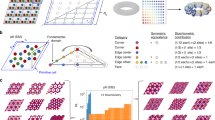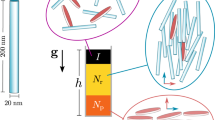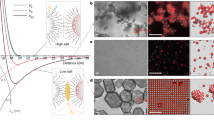Abstract
Colloidal suspensions of highly charged, monodisperse polymer spheres exhibit long-range (crystalline) translational ordering in appropriate conditions of charge, number density, counterion concentration and temperature1–5. These ‘colloidal crystals’, which can conveniently be made to have lattice parameters comparable to or greater than optical wavelengths, offer unique opportunities for the study of the collective static and dynamic behaviour of strongly interacting spherical particles. For example, such systems may readily be probed by relatively simple but powerful light scattering spectroscopic techniques6,7. Furthermore, the ordering itself offers intrinsic advantages, both experimental (for example, fluctuations normally observable only about the k-space origin appear about Bragg spots, with reduced stray light and multiple scattering effects), and theoretical (the simplicity of calculating on the basis of a known rather than only statistically defined structure is well appreciated from experience with atomic solids and liquids). To exploit these ordered structures fully, reliable methods of producing orientated single crystals suitable for light scattering and other optical studies must be developed. For light scattering from bulk samples the primary requirement is that the ratio of interparticle spacing to diameter, a/d, be sufficiently large. This reduces interference by multiple scattering and renders the particle scattering factor nearly constant through those scattering angles [|k|<(2→5)2π/a] where the most useful information concerning crystal structure and dynamics appears. We now describe a technique whereby single body-centred cubic (b.c.c.) colloidal crystals, well suited for light scattering and having particular orientations, may be produced.
This is a preview of subscription content, access via your institution
Access options
Subscribe to this journal
Receive 51 print issues and online access
$199.00 per year
only $3.90 per issue
Buy this article
- Purchase on Springer Link
- Instant access to full article PDF
Prices may be subject to local taxes which are calculated during checkout
Similar content being viewed by others
References
Luck, W., Klier, M. & Wesslau, H. Ber. Bunseg. Phys. Chem. 67, 75–83 (1963).
Hiltner, P. A. & Krieger, I. M. J. phys. Chem. 73, 2386–2391 (1969).
Williams, R. & Crandall, R. S. Phys. Lett. 48A, 225–226 (1974).
Kose, A., Ozaki, M., Takano, K., Kobayashi, Y. & Hachisu, S. J. Coll. Int. Sci. 44, 330–338 (1973).
Williams, R., Crandall, R. S. & Wojtowicz, P. J. Phys. Rev. Lett. 37, 348–351 (1976).
Brown, J. C., Pusey, P. N., Goodwin, J. W. & Ottewil, R. H. J. gen. Phys. A8, 664–682 (1975).
Schaefer, D. W. & Ackerson, B. J. Phys. Rev. Lett. 35, 1448–1451 (1975).
James, R. W. The Optical Principles of the Diffraction of X-Rays Ch. 5 (Cornell University Press, 1965).
James, R. W. The Optical Principles of the Diffraction of X-Rays Ch. 8 (Cornell University Press, 1965).
Alexander, S. & McTague, J. Phys. Rev. Lett. 41, 702–705 (1978).
Author information
Authors and Affiliations
Rights and permissions
About this article
Cite this article
Clark, N., Hurd, A. & Ackerson, B. Single colloidal crystals. Nature 281, 57–60 (1979). https://doi.org/10.1038/281057a0
Received:
Accepted:
Published:
Issue Date:
DOI: https://doi.org/10.1038/281057a0
This article is cited by
-
Unified explanation for self-assembly of polymer-brush-modified nanoparticles in ionic liquids
Polymer Journal (2023)
-
Liquid-crystalline half-Skyrmion lattice spotted by Kossel diagrams
Scientific Reports (2018)
-
A new class of copolymer colloids with tunable, low refractive index for investigations of structure and dynamics in concentrated suspensions
Colloid and Polymer Science (2017)
-
A Compact Device for Colloidal Crystal Studies on Tiangong-1 Target Spacecraft
Microgravity Science and Technology (2014)
-
In situ high-temperature electron microscopy of 3DOM cobalt, iron oxide, and nickel
Journal of Materials Science (2008)
Comments
By submitting a comment you agree to abide by our Terms and Community Guidelines. If you find something abusive or that does not comply with our terms or guidelines please flag it as inappropriate.



